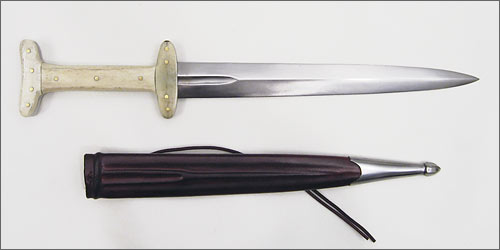
 |
|
|
Tod's Stuff Bone-handled Baselard
A hands-on review by Chad Arnow Named for the supposed city of its birth—Basel, Switzerland—the baselard was nonetheless a form popular throughout Europe, not just in Switzerland. Unlike some dagger forms known almost exclusively as weapons of the warrior class (like the rondel dagger), the baselard is frequently seen hanging from the belts or tucked behind the pouches of civilians in their funeral monuments and in other period art. The form is a simple one, consisting of a blade (very often double-edged) and a hilt shaped like a capital "I". This eminently practical shape is an ergonomic one, fitting easily and securely into a bare hand or gauntlet. This particular form of baselard, with its grip comprised of slabs of an organic material, was popular in the 14th and early 15th centuries. Overview Though he makes armour, crossbows, swords, and many other medieval goods, Leo "Tod" Todeschini of Tod's Stuff is also well-known for his small blades: daggers and knives. I am among his many satisfied customers. During the course of ordering a seax for my own collection, Tod asked if myArmoury needed any contest prizes. I let him know we were always appreciative of generous donations and he offered to make something for a future giveaway. I was quite surprised later to find out that he made both this baselard and a nice medieval knife and donated them as contest prizes. As with a number of Tod's pieces, this baselard is not based on a specific example. It incorporates features found on several surviving examples as well as things seen in period art.  Measurements and Specifications:
Replica created by Tod's Stuff of Oxford, United Kingdom. Handling Characteristics As a contest prize, I don't feel comfortable cutting with the dagger which limits my commentary on handling to "dry handling" only. The dagger fits my hand quite well with my hand easily locking between the guard and "pommel". It might be tight if I were to wear a gauntlet. I can't consider this a flaw for two reasons: 1) baselards were common among the civilian population and 2) as a custom maker, Tod is more than capable of sizing the knife to the buyer's needs (ie. If I had commissioned this as a custom project, we would have sized it for my gauntleted hands, not made it more "average" to fit whoever is lucky enough to win the dagger). Because of the amount of metal in the hilt, it balances well back toward the hand, making the tip lively. While I'm sure it could cut effectively, it would be most lethal in a thrust, whether in an over-handed or under-handed grip. Fit and Finish
The blade is nicely polished, perhaps one of the more evenly polished daggers I've seen from Tod. It has fewer grind marks overall and a more satin finish. The fullers are obviously put in by hand and the center line is not quite centered on one face of the blade. Those who are used to seeing weapons made with CNC machines may find these quirks odd or off-putting. Having seen some museum pieces and held a few antiques, these features are not uncommon on surviving historic pieces. One could even say exact symmetry and straight lines are the exception to the rule. The hilt is nicely done, with the bone grip slabs mated nicely with the steel of the grip section. The bone is attached with brass pins. There are some hairline cracks in the bone, but the grip is rock solid, from the combination of pins and epoxy. Tod has inlaid brass strips into the side of the grip, decorating what would otherwise be a quite plain expanse of steel. Flux from attaching the wire stains some of the strips, but probably could be easily removed through polishing. The scabbard is a deep burgundy color and is made of two layers of leather. The chape is of steel. The leather itself is embossed to echo the fuller and center line. The scabbard includes a thong for attaching to a belt. Conclusion This Tod's Stuff baselard is a piece I'd be proud to own. It's a nice example of the form and appropriately sized and decorated to be carried in a civilian setting or put with a kit and harness for warfare. It would be a handy weapon to have in many circumstances and a great addition to most any collection. About the Author Chad Arnow is a classical musician from the greater Cincinnati area and has had an interest in military history for many years. Though his collecting tends to focus on European weapons and armour of the High Middle Ages, he enjoys swords, knives and armour from many eras. Acknowledgements Photographer: Chad Arnow |